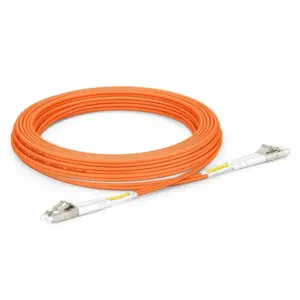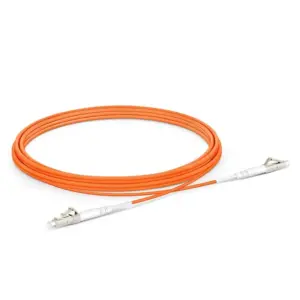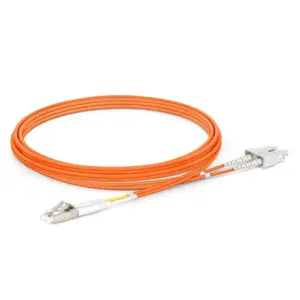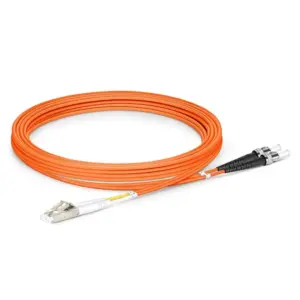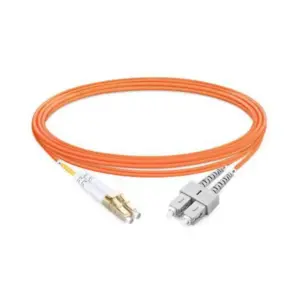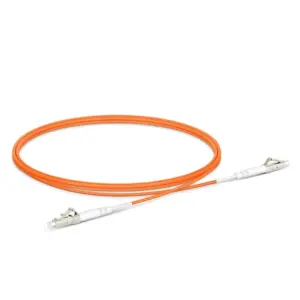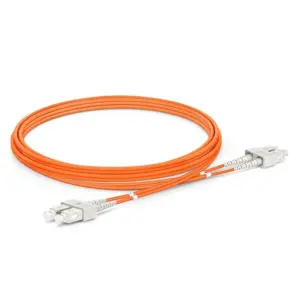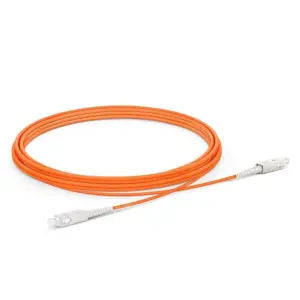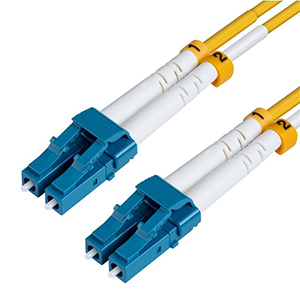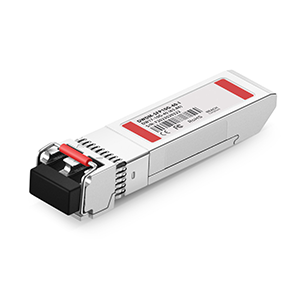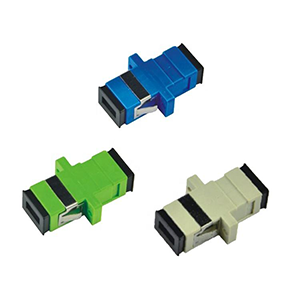As a common multi-mode optical fiber jumper, OM1 plays an important role in the field of optical fiber transmission. In this article, I will introduce the basic concepts, characteristics and use of OM1 fiber optic patch cords in different application fields. I will also discuss the structure and parameters of OM1 fiber optic patch cords, transmission performance and comparison with other fiber optic grades. Finally, I will discuss the deployment, maintenance considerations, and future development trends of OM1 fiber optic patch cords.
Introduction to OM1 fiber optic patch cord
Definition and characteristics:
OM1 fiber optic patch cord is a multi-mode fiber optic patch cord that uses 1Gbps Ethernet transmission rate. OM1 stands for “Optical Multimode 1” and is a level in multimode fiber classification. The following are some features of OM1 fiber optic patch cords:
-
Fiber core diameter: The fiber core diameter of OM1 fiber jumper is 62.5 microns (μm). Fiber core diameter refers to the diameter of the center of the fiber, which determines how optical signals are transmitted in the fiber.
-
Transmission distance: The transmission distance of OM1 optical fiber jumper is relatively short, usually less than 2 kilometers. Under high-speed transmission, the transmission distance may be shorter.
-
Transmission rate: OM1 optical fiber jumper is suitable for 1Gbps Ethernet transmission rate. It can support traditional Ethernet and Fast Ethernet applications.
-
Attenuation: The typical attenuation range of OM1 fiber optic patch cord is 2.5 to 3.5 decibels (dB) per kilometer. Attenuation refers to the signal loss of optical signals during optical fiber transmission.
Multimode optical fiber classification:
Multimode optical fiber is divided into different levels based on fiber core diameter and transmission performance. OM1 is one of them and represents a specific grade of multimode fiber. Here are some common multimode fiber grades and their characteristics:
-
OM1: The fiber core diameter of OM1 optical fiber jumper is 62.5μm, which is suitable for 1Gbps Ethernet transmission rate. It has relatively low transmission distance and attenuation, making it suitable for shorter distance applications.
-
OM2: The fiber core diameter of OM2 optical fiber jumper is 50μm, which is suitable for 1Gbps Ethernet transmission rate. Compared with OM1, OM2 fiber has lower attenuation and longer transmission distance.
-
OM3: The fiber core diameter of OM3 fiber jumper is 50μm, which is suitable for high-speed transmission, such as 10Gbps, 40Gbps and 100Gbps. It can support longer transmission distances.
-
OM4: The fiber core diameter of OM4 fiber optic jumper is 50μm, which is similar to OM3 and is suitable for high-speed transmission. OM4 fiber has lower attenuation and longer transmission distance, making it suitable for high-performance networks.
These different levels of multimode fiber optic patch cords differ in transmission performance, transmission distance, and supported transmission rates. Depending on the specific application needs and network requirements, it is important to select the appropriate fiber grade.
Structure and parameters of OM1 optical fiber jumper
structure:
OM1 optical fiber jumper adopts multi-mode optical fiber structure and consists of the following main parts:
-
Fiber core (Core): The fiber core is the central part of the fiber jumper and is used to transmit optical signals. In the OM1 fiber optic patch cord, the diameter of the fiber core is 62.5 micrometers (μm).
-
Cladding: The cladding is the outer covering of the optical fiber core and is used to protect the transmission of optical signals. In OM1 fiber optic patch cords, the diameter of the cladding is 125 micrometers (μm).
-
Jacket: The jacket is the outer protective layer of the optical fiber jumper, used to protect the optical fiber from physical damage and environmental effects. The sheath is usually made of wear-resistant and corrosion-resistant materials, such as PVC (polyvinyl chloride).
parameter:
OM1 fiber optic patch cord has the following main parameters:
-
Core Diameter: The fiber core diameter of OM1 optical fiber jumper is 62.5 microns (μm). It determines the transmission mode and propagation characteristics of optical signals in optical fibers.
-
Mode Field Diameter: The mode field diameter of OM1 optical fiber jumper is approximately 50 microns (μm). The mode field diameter is the main propagation area of optical signals in optical fibers, affecting signal transmission loss and mode coupling.
-
Typical Attenuation: The typical attenuation range of OM1 fiber optic patch cord is 2.5 to 3.5 decibels (dB) per kilometer. Attenuation is the signal loss of optical signals during optical fiber transmission, which measures the weakening of the intensity of the optical signal.
-
Transmission Rate: OM1 optical fiber jumper is suitable for 1Gbps Ethernet transmission rate. It can support traditional Ethernet and Fast Ethernet applications.
These parameters are important indicators for evaluating the performance and suitability of OM1 fiber optic patch cords. When selecting fiber optic patch cords, these parameters need to be considered based on specific application needs and network requirements to ensure that the fiber optic patch cord can meet the required transmission performance and reliability.
Application fields of OM1 optical fiber patch cord
Local Area Network (LAN):
OM1 fiber optic patch cords are widely used in enterprise and campus LANs. The following are some typical application scenarios:
-
Data center: OM1 fiber optic jumpers can be used to connect servers, storage devices, network switches and other equipment to support high-speed data transmission and communication within the data center.
-
Enterprise network: In an enterprise’s internal LAN, OM1 fiber optic patch cords can be used to connect network devices, such as switches, routers and servers, between different floors or different offices. It provides high-speed, reliable data transmission to support the daily business needs of enterprises.
-
Campus network: OM1 optical fiber jumpers can be used to connect network equipment between different buildings, classrooms and laboratories on campus. It provides fast data transfer to support teaching, research and management activities of educational institutions.
Ethernet-based applications:
OM1 fiber optic patch cords also find widespread use in Ethernet-based applications. The following are some common Ethernet application scenarios:
-
1Gbps Ethernet: OM1 optical fiber jumper is suitable for 1Gbps Ethernet transmission rate, so it is widely used in Ethernet environments that require high-speed data transmission. It can connect devices such as servers, network switches, routers, and workstations.
-
Fast Ethernet: OM1 fiber optic patch cord is also suitable for Fast Ethernet applications, which have a transmission rate of 100Mbps. It is commonly used in early Ethernet deployments and some lower-speed network connections.
-
Video transmission: The high bandwidth characteristics of OM1 fiber optic patch cord make it very suitable for transmitting high-definition video and audio signals. It can be used to connect video surveillance equipment, video conferencing systems, broadcast equipment, etc.
OM1 fiber optic patch cords provide reliable high-speed data transmission in LAN and Ethernet-based applications. It is widely used in enterprises, campuses and other scenarios that require fast and reliable network connections.
Transmission performance of OM1 fiber optic patch cord
Transmission distance:
The transmission distance of OM1 optical fiber jumper mainly depends on the transmission rate and attenuation characteristics of the optical signal. The following are the general transmission distances of OM1 fiber optic patch cords:
-
1000BASE-SX (1Gbps Ethernet): For 1Gbps Ethernet transmission rate, the typical transmission distance of OM1 fiber optic patch cord is about 275 meters.
-
100BASE-FX (100Mbps Ethernet): For 100Mbps Ethernet transmission rate, the typical transmission distance of OM1 fiber optic patch cord is about 412 meters.
Please note that these transmission distances are based on standard conditions and typical fiber attenuation values. The actual transmission distance may be affected by other factors, such as light source power, connection quality, and fiber quality.
Transmission rate:
OM1 fiber optic patch cord shows different performance at different transmission rates. The following are some common transfer rates and corresponding performance:
-
10Mbps: OM1 fiber optic jumper can support a transmission rate of 10Mbps and provide reliable data transmission, suitable for lower-speed network connections.
-
100Mbps: OM1 optical fiber jumper is suitable for 100Mbps transmission rate, provides higher bandwidth and reliability, and is suitable for Fast Ethernet applications.
-
1Gbps: OM1 fiber optic patch cord is suitable for 1Gbps transmission rate, provides higher bandwidth and transmission capacity, and is suitable for most modern Ethernet applications.
It should be noted that the performance of OM1 fiber optic patch cord will be affected by factors such as fiber attenuation, connector quality and light source power. When selecting and deploying OM1 fiber optic patch cords, the required transmission rate and actual application scenarios should be considered to ensure that the fiber optic patch cords can meet performance requirements.
Comparison of OM1 fiber optic patch cord with other fiber grades
Performance comparison:
There are some performance differences between OM1 fiber optic patch cords and other multimode fiber grades (such as OM2, OM3, OM4). Here’s how they compare:
-
Bandwidth: OM1 fiber optic patch cord has a lower bandwidth, usually 200 MHz·km. In comparison, OM2 fiber has a bandwidth of 500 MHz·km, and OM3 and OM4 fiber have higher bandwidths of 2000 MHz·km and 4700 MHz·km respectively. The higher the bandwidth, the higher the rate of data that fiber can carry.
-
Transmission distance: The transmission distance of OM1 fiber optic patch cord is relatively short, especially for high-speed data transmission. Typical OM1 fiber transmission distance is 275 meters (1Gbps Ethernet), while OM2, OM3 and OM4 fiber can achieve longer transmission distances.
-
Attenuation: OM1 fiber has a higher attenuation value, with a typical attenuation range of 2.5 to 3.5 dB/km. In comparison, OM2, OM3 and OM4 fibers have lower attenuation values of 2.0 to 3.0 dB/km, 1.0 to 2.3 dB/km and 0.8 to 2.3 dB/km respectively. Lower attenuation values mean that optical signals can be transmitted over longer distances.
Applicable scene:
Best practices for selecting OM1 fiber patch cords or other fiber grades will vary based on actual network environment and needs. Here are some guidelines:
-
OM1 optical fiber patch cord is suitable for shorter distance transmission needs, such as LAN connections within enterprises or network connections within campuses. It performs well in scenarios with lower transmission rates (such as 10Mbps, 100Mbps).
-
If you need higher transmission bandwidth and longer transmission distance, you can consider using OM2, OM3 or OM4 optical fiber. They are suitable for higher-speed Ethernet applications, such as 1Gbps, 10Gbps or even higher-speed data transmission.
-
When building a new fiber optic network, consider choosing higher-grade fiber optics (such as OM3 or OM4) to provide better future scalability and compatibility. This ensures that the network can support higher data transmission rates and emerging fiber optic technologies.
To sum up, whether to choose OM1 optical fiber jumper or other optical fiber levels should be comprehensively considered based on actual needs, transmission distance, budget and other factors. For long-distance, high-rate data transmission needs, newer fiber grades such as OM3 and OM4 may be more suitable, while OM1 fiber optic patch cords are more suitable for shorter distances and lower-rate applications.
Precautions for deployment and maintenance of OM1 optical fiber patch cord
Installation and connection:
When installing and connecting OM1 fiber optic patch cords, here are some considerations:
-
Fiber handling: When handling optical fibers, avoid bending, stretching, or over-bending the optical fiber to prevent attenuation and damage to the optical signal. Make sure the fiber bend radius meets the manufacturer’s specifications.
-
Connector protection: During the connection process, handle fiber optic connectors carefully to avoid scratching or bending the connector end face. Use devices such as protective caps or sleeves to protect connector end faces from dust, dirt, and damage.
-
Clean environment: When installing fiber optic jumpers, ensure that the working environment is clean and try to avoid contact with dust, moisture and chemicals. This helps maintain the quality and reliability of fiber optic connections.
-
Connection verification: After completing the connection, use fiber optic test equipment to verify. By measuring parameters such as attenuation and reflection loss of fiber optic connections, you can ensure that the connection quality meets requirements.
Maintenance and care:
The following are some key points for maintaining and maintaining OM1 fiber optic patch cords:
-
Clean the fiber optic connector: The end face of the fiber optic connector should be kept clean. Use a non-woven cloth and an appropriate cleaning solvent (such as a specialized fiber optic cleaner) to gently wipe the connector end face to remove contaminants such as dust, dirt, and grease.
-
Prevent bending and stretching: Avoid applying excessive bending or stretching force on fiber patch cords. Make sure the fiber’s bend radius meets the manufacturer’s specifications and avoid hanging heavy objects on the fiber.
-
Protect fiber optic patch cords: Store fiber optic patch cords in a dry, clean environment when not in use. Avoid exposing optical fibers to adverse environments such as excessive temperature, humidity, and strong light.
-
Regular inspection and testing: Regularly check the connection status and performance of the fiber jumper. Use fiber optic testing instruments to perform attenuation and continuity tests to ensure the normal operation and transmission performance of fiber optic patch cords.
Please note that if you encounter problems with fiber optic patch cords or require more complex maintenance work, it is recommended to consult a professional fiber optic technician or vendor support to ensure correct operation and maintenance steps.
Future development trend of OM1 fiber optic patch cord
As new generations of standards and technologies continue to develop, OM1 fiber optic patch cords may face some challenges. New generation optical fiber standards such as OM5 and OM6 will provide higher bandwidth and longer transmission distance, gradually replacing the application of OM1 level in high-speed networks. However, for some specific application scenarios or limited budget situations, OM1 fiber optic patch cord still has certain applicability and economy.
With the continuous development of fiber optic networks, OM1 fiber optic patch cords may still play a role in some specific LAN environments in the future. Especially for small to medium-sized business or campus networks, their short-range transmission needs and limited budgets may make OM1 an affordable option.
Summarize:
OM1 optical fiber jumper, as a common multi-mode optical fiber grade, plays an important role in the local area network. Although its performance is relatively low, it still has certain applicability for data transmission requirements over shorter distances and lower rates. When selecting fiber optic patch cords, you need to consider comprehensive considerations based on specific needs, budget, and future development trends.
Maintaining the correct installation, connection, and maintenance of fiber optic patch cords can ensure good transmission performance and stability. In the future, with the introduction of new generation optical fiber standards, optical fiber networks will further develop, and OM1 optical fiber jumpers may gradually be replaced or restricted in use in certain specific scenarios.
-
OM1 LC to LC UPC Duplex Fiber Patch Cord
-
OM1 LC to LC UPC Simplex Fiber Optic Patch Cord
-
OM1 LC to SC UPC Duplex Fiber Patch Cord
-
OM1 LC to ST UPC Duplex Fiber Patch Cord
-
OM1 Multimode Duplex Fiber Optic Patch Cord
-
OM1 Multimode Single-Core Fiber Optic Patch Cord
-
OM1 SC to SC UPC Duplex Fiber Patch Cord
-
OM1 SC to SC UPC Simplex Fiber Optic Patch Cord


